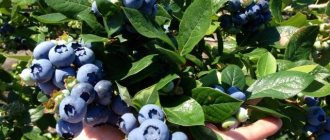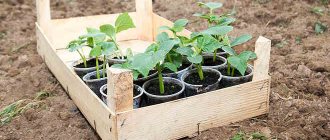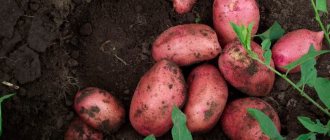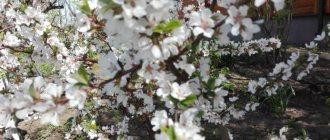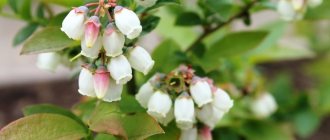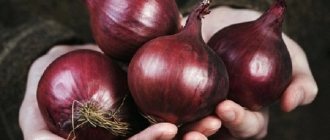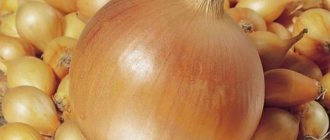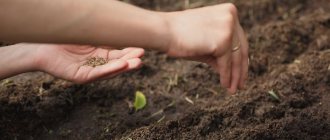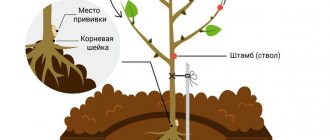History of selection
The name of the blueberry variety Northland (“Northland”) translated from English means “Northern Land”. It was obtained at Michigan State University (USA) as part of a program to develop the most frost-resistant varieties of this crop for cultivation on an industrial scale.
Work on it was carried out by S. Johnston and J. Moulton since 1948. Scientists managed to cross the high-bush Berkeley blueberry with 19-N (a hybrid of the low-bush blueberry and a seedling of the Pioneer variety).
Northland became the result of their work in 1952. This blueberry variety was officially introduced into cultivation in 1967.
Description of the berry crop
Northland blueberries are valued not only for their frost resistance, high yields and excellent taste of the berries. Thanks to its decorative appearance, a plant of this variety looks very impressive on the site in spring, autumn and summer, which gives the landscape designer a luxurious opportunity to show his imagination.
General idea of the variety
The Northland blueberry variety is a low-growing variety. On average, the height of the bush is about 1–1.2 m, but at the same time it is powerful and spreading. As a rule, it produces a lot of shoots, often very dense.
The root system of plants of this variety, like blueberries in general, is superficial and fibrous. Characterized by the absence of root hairs.
Northland blueberry shoots are smooth and straight. They remain green throughout the year. The branches of an adult plant of this variety are flexible and can withstand large amounts of snow.
The leaves of the Northland blueberry are oblong, smooth, with a slightly glossy surface. In summer their color is bright green, in autumn they turn fiery red. The length of the leaf blade is about 3 cm.
The inflorescences of this blueberry variety are small, five-toothed, and bell-shaped. They are painted pale pink.
Berries
Northland blueberries are round, dense, medium in size (up to 1.6 cm). Their skin is not rough, light blue in color, with a slight bluish tinge. The scar on its surface is dry, medium or small.
The taste of Northland blueberries is sweet, pleasant, with a delicate aroma, very reminiscent of their wild “relative”. The variety was given a high tasting score - 4.0 (on a five-point scale).
Attention! Blueberries are often confused with another similar berry crop - blueberries. However, distinguishing them from each other is not so difficult. The blueberry bush is taller than the blueberry bush, its shoots are harder, and their bark is lighter. The juice of the first berries is light, almost transparent, while the second is dark and can easily stain clothes and hands.
Eating blueberries
In cooking, there are many ways to consume this healthy, vitamin-rich berry, primarily by eating it raw. The maximum concentration of vitamins and bright taste with a wine aftertaste leave no one indifferent.
Did you know? The average lifespan of one blueberry bush is 90 years. In the wild, some specimens begin to bear fruit only in the 18th year of life.
The following types of preparations are also practiced:
- jams;
- jam;
- compotes;
- jelly;
- freezing fresh fruits;
- pureed with sugar and frozen blueberries;
- dried (in a dehydrator).
Characteristic
Northland blueberries are characterized by a number of strengths that distinguish them favorably from other garden varieties of this crop.
Main advantages
The frost resistance of this variety is one of its main advantages. According to American sources, Northland blueberries can easily withstand winter temperatures dropping to -35 degrees. Its flowers can withstand light frosts. Bred for the northern United States and Canada, this variety is excellent for cultivation in cold regions with harsh climates.
Caring for Northland blueberries will not seem difficult even to a novice gardener. The main features that should be taken into account are maintaining the necessary soil moisture and acidity, as well as proper feeding of plants of this variety.
Unfortunately, Norland blueberries are not drought tolerant. It feels the lack of moisture very acutely, so it is extremely important to follow the correct watering regime.
Advice! During the dry and hot period of summer, it is recommended to additionally irrigate the leaves of this variety with warm water in the evening.
Northland blueberries are confidently recommended to be grown for industrial processing. Its berries are well stored and transported. This blueberry variety has proven itself well on plantations where manual harvesting is practiced. However, the berries can also be collected mechanically.
Flowering period and ripening time
Northland blueberries bloom in late spring, profusely and for quite a long time (approximately 3 weeks).
In terms of fruit ripening, the variety is classified as mid-early: the berries begin to ripen in mid-July. This process occurs gradually and usually stretches until the beginning of August.
Attention! Ripe blueberries of this variety quickly fall off, so it is recommended to harvest them at least a couple of times a week.
Yield indicators, fruiting dates
Northland blueberries are capable of bearing fruit in their second year.
This variety is famous for its regular, very high yield. On average, you can collect 4–5 kg of berries from a bush, but the maximum quantity is 8 kg.
Important! Given the most favorable conditions, a Northland blueberry bush can live up to 30 years.
Area of application of berries
The purpose of Northland blueberries is universal. Its fruits are very tasty fresh; they make excellent preparations (jams, confitures, preserves, compotes) and sweet desserts (jelly, marshmallows). In addition, the berries are perfectly stored dry and frozen.
Resistance to diseases and pests
The Northland blueberry variety is characterized by good resistance to pests and a number of diseases, in particular to the berry mummification virus. However, this crop can still suffer from gray rot, stem cancer, physalosporosis and moniliosis.
Important! If a plant of this variety is damaged by a viral or fungal infection, it is very often necessary to burn the entire bush.
Most often, Northland blueberries are damaged by aphids, bud mites and flower beetles.
In addition, birds love to feast on the aromatic sweet berries of this variety. To combat them, it is recommended to attach strips of polymer film to the branches of blueberry bushes, which repel birds with its shine and rustling in the wind, or multi-colored fabric ribbons.
Advantages and disadvantages of the variety
It is obvious that some of the disadvantages that the Northland blueberry variety is endowed with pale against the general background of its inherent advantages:
| Advantages | Flaws |
| High winter hardiness and resistance to low temperatures | Weak resistance to drought |
| Early fruit ripening | Increased sensitivity to wind and drafts |
| low bush | It often becomes necessary to destroy the entire bush if it becomes sick. |
| Sweet, tasty berries | High demands on soil acidity |
| High and stable yields | Slow reproduction rates |
| Low maintenance | |
| Good resistance to pests and diseases | |
| Decorative appearance |
Varieties of garden highbush blueberries
At the beginning of the 20th century, the Bruke variety was selected from a wild blueberry species. Subsequently, the Russell variety, characterized by frost resistance and early ripening, was developed from low-growing blueberries. After crossing these varieties, biologists obtained excellent results, and after adding southern blueberries to them, they were able to develop four valuable varieties. This is how a new crop entered gardening - highbush blueberry. Today, about 50 varieties are registered in the United States.
Highbush blueberry is a branched shrub with a height of 1.2 to 2.5 m. The plant is characterized by rapid growth and good shoot-forming ability. The size of the fruit depends on the variety, often reaching up to 4 g. The taste of the berries is characteristic of the species, but sweeter than that of wild forms.
New varieties of highbush blueberries are quite winter-hardy and frost-resistant, and can withstand temperatures down to -30°C. At lower temperatures they may freeze, but with proper care they quickly recover. Spring frosts are more dangerous for crop loss; blueberry flowers cannot tolerate temperatures below -2°C.
Read also: Culling cattle from the main herd: basic principles
Early varieties: River, Duke, Patriot and others
The fruits of early varieties of the crop begin to ripen in the middle zone in the second half of July.
The best varieties:
The Reka variety is distinguished by its extraordinary taste of fruits and high yield (8-18 kg per bush).
The Duke variety is especially popular in America. The peculiarity of the plant is late flowering, which eliminates crop loss due to damage to flowers by spring frosts. Despite this, the fruits ripen by mid-July. Shrubs of this variety have strong fruits with a dessert taste and pronounced aroma.
The peculiarity of the Patriot variety is plasticity to soil conditions and resistance to late blight. Therefore, growing plants of this variety does not bring additional trouble to the gardener.
Late varieties: Bluecrop, Jersey, Bonus
The fruits of shrubs of these varieties begin to ripen in the first half of August.
The best varieties:
The Jersey variety is one of the best pollinators; this is worth taking into account when selecting shrubs for combined planting. In addition, it is resistant to late spring frosts and viral diseases. This is an old variety tested by many gardeners.
Bluecrop is the most reliable, consistently fruiting variety. Productivity 6-9 kg per bush. The fruits of this shrub are valued for their high transportability and resistance to natural disasters. The Toro variety is highly frost-resistant and can withstand temperatures down to -34°C.
A real find for those who like to eat fresh fruits is the Bonus variety. The fruit diameter of this plant reaches up to 30 mm. The pulp is sweet and dense, so the fruits can withstand long-term transportation.
Landing rules
In order for blueberries to take root and feel good on the site, it is necessary to plant them correctly.
Recommended timing
It is possible to plant Northland blueberries in the ground in early spring and early autumn. But experienced gardeners still recommend the first option: then by the time cold weather sets in, the bush will have time to get used to the new conditions and will get stronger.
Choosing a suitable location
The area in the garden where it is planned to place Northland blueberries should be open and generously illuminated by the sun: this variety practically does not bear fruit in the shade. In this case, the place must be reliably protected from drafts.
You cannot plant a Northland blueberry bush near fruit trees. The berries will be sour because they will not be able to absorb the required amount of sugar.
Important! It is advisable that the plot of land for planting blueberries of this variety should be “rested” - that is, nothing has grown on it for several years.
Soil preparation
Northland blueberries are very sensitive to soil. The optimal substrate for it will be a light, humus-rich substrate - moist, but well-drained.
Warning! The soil must be acidic – have a pH level between 3.5–5.0. The optimal indicator recommended for this variety by American farmers is 4.5–4.8.
The ideal option, combining all the above qualities, is peat (high-moor or transitional), as well as mixtures based on it.
Selection and preparation of seedlings
It is advisable to buy varietal blueberry seedlings, including Northland, in trusted places: special nurseries or exhibition grounds. Biennial young plants with a closed root system and shoot lengths from 35 to 50 cm take root best.
Before planting in the ground, it is recommended to place a container with a seedling of this variety in a container of water for half an hour. This procedure will help to gently straighten the roots.
Algorithm and landing scheme
Northland blueberries are planted this way:
- dig a planting hole about 0.5 m deep and 50–60 cm in length and width;
- a layer of drainage (gravel or sand) is placed on the bottom;
- fill the hole with a mixture of peat, soil, coniferous litter and humus;
- carefully lower the seedling, straightening its root system, sprinkle with the prepared soil mixture;
- mulch the soil with peat, sawdust, tree bark or pine nut shells (5–10 cm layer);
- water the plant with water - possibly with the addition of citric acid (40 g per 10 l).
Important! In order to ensure the cross-pollination necessary for berry set, several bushes of 3-4 different varieties should be planted on the plot.
Holes for planting Northland blueberries should be placed at a distance of 1.5 m. The distance between rows of bushes of this variety should be 2–2.5 m.
You can learn how to properly plant blueberries in the ground and care for them from the video:
Alternative options for planting garden blueberries
Considering that the plant prefers acidic soil, the best option for planting it is peat. However, if another type of soil predominates on the site, then it is possible to plant blueberries without it.
Planting without using peat
We plant garden blueberries without peat as follows. We fill the planting hole with soil from the garden plot and acidify it. To do this, we use oxidizing drugs. Pour the powder into a hole 15-20 cm deep and mix it with planting soil, while adhering to the dosage described in the instructions. The product will dissolve during watering and oxidize the soil.
As traditional methods of oxidation, you can use acids such as oxalic and citric. Prepare a solution at the rate of 1 tsp/3 liters of water. When using vinegar (9%), take 100 ml/10 l of water. We water the plant with ready-made mixtures 2 times a year: after the end of frost and before preparing the winter crop.
Landing on the ridges
If clay soil predominates in the garden plot, we plant the plant using the “ridges” method. To do this, we dig a hole for planting up to 15 cm high. Next, we form an elevation on top with sand, earth, sawdust and peat. We place a seedling in the center of the hill, do not bury it, and scatter sawdust around the stem in a layer of up to 12 cm. Thus, the root mass of the bush is on the surface, and excess water runs off and does not linger in the ground.
Planting in pine needles
The lack of peat can also be compensated for by using a coniferous substrate. We mix soil from the garden plot with forest soil (take it from the part where spruce and pine trees grow) and rotted needles of coniferous trees. This mixture is looser and provides full access of oxygen to the roots of the plant.
Subsequent care of the crop
The Northland blueberry variety is unpretentious in terms of care. However, there are certain nuances that should be taken into account so that the plant does not get sick and produces stable yields.
Necessary activities
It is recommended to water Northland blueberries regularly (about once a week, more often during the fruiting period - once every 4-5 days). Approximate norm: 1 bucket of water per adult plant. It should be divided into 2 doses - morning and evening.
Advice! To water the bushes of this variety, it is also convenient to use special drip irrigation systems.
Northland blueberries should be fertilized with mineral (nitrogen-containing) or complex fertilizers in three stages:
- at the beginning of sap flow (half of the annual norm);
- another quarter is introduced at the time of flowering;
- the remainder is added during the harvest.
Warning! You cannot feed blueberries with organic fertilizers - they are destructive for them!
Necessary procedures for caring for Northland blueberries include loosening the soil. It is carried out several times during the season. It should be taken into account that the roots of the plant are located close to the surface - accordingly, the soil should be loosened carefully, without going deeper into the ground than 10 cm.
An important technique that helps suppress the growth of weeds, retain moisture and enrich the soil with organic matter is mulching. The layer of mulch under the bushes of this blueberry variety can be within 5 cm. As such, you can use cut grass, peat or crushed tree bark.
Shrub pruning
Regular and proper pruning of Northland blueberries is the key to its health and productivity.
For sanitary purposes, this procedure is carried out in the spring, starting from 2–4 years of age of the bushes. It helps to form a strong skeleton of the plant and serves as a prevention of branch fractures during the fruiting period under the weight of the berries.
Important! To increase the yield of Northland blueberries, it is recommended to prune shoots older than 6–7 years.
In summer and autumn, dried and diseased branches are removed by pruning.
It is recommended to remove flowers from annual plants of this variety in the spring.
Preparing for winter
Northland is a frost-resistant blueberry variety. However, in regions where low temperatures can last for a long time, it will need shelter in winter.
As such, burlap, spunbond or any other breathable material is used, stretched over a base of pegs or arcs.
Important! Polyethylene film cannot be used for these purposes!
How are garden blueberries different? Photos are attached!
Before you start studying this berry crop in detail, you need to know the history of its origin. How do garden blueberries differ from their natural “wild” counterparts?
This page contains photos of garden varieties, which are primarily distinguished by higher growth of shoots and a large number of berries on 1 stem.
In addition, it is worth paying attention to the size of the berries and the yield from 1 bush. The prototype of this culture is the wild marsh berry, which grows in nature on peat bogs and in marshy areas.
The prototype of this culture is the wild marsh berry, which grows in nature on peat bogs and in marshy areas.
The prototype of this culture is the wild swamp berry, which grows in nature on peat bogs and in marshy areas.
Its prevalence in a large number of regions is explained by its excellent resistance to unfavorable growing conditions. These plants thrive even in tundra conditions, complementing the sparse landscape of this area.
In the wild, one bush can grow well and bear fruit for more than 50 years.
In culture, such indicators are difficult to achieve, since rejuvenation of the branching part does not occur. Therefore, garden blueberries are usually replanted with new cuttings at least once every 6 years. Otherwise, the yield drops catastrophically due to a decrease in the size of the berries.
Popular wisdom subtly noted all the beneficial and amazing properties of this berry. So, for its love for the neighborhood with wild rosemary, the culture is called a drunkard. This is due to the fact that during the ripening period of the berries it is usually hot; this condition contributes to the release of a large amount of specific essential oils by wild rosemary.
When they are inhaled, a person becomes slightly intoxicated. It goes without saying that the next day you will have a headache, like a hangover. Therefore, it is natural to have another name - hemlock.
But the popular name blueberry is explained even more simply. The berry secretes a characteristic blue juice that stains hands, fabrics and everything it comes into contact with blue.
How else do garden blueberries differ from their wild counterparts besides their higher growth (70 cm versus 25-30 cm in the wild)? Well, at least the period of entry into fruiting.
In nature, this berry takes a long time to develop; it requires at least 15 years of growth and development in order to produce the first berries. But with garden varieties everything is much simpler.
Most of them begin to produce moderate yields already in the second year after planting. The bushes reach full strength 3 years after planting.
Look at the photo of garden blueberries - the elegance and grace of the bushes strewn with clusters of magnificent aromatic berries:
Diseases and pests, methods of control and prevention
The most common diseases that can affect Northland blueberries are:
| Disease | Manifestations | Control and prevention measures |
| Stem cancer | The appearance of reddish spots on the leaves and bark, which quickly darken and increase in size. The stems begin to dry out | Affected organs must be cut out and burned. Treatment with fungicides (Topsin, Fundazol). For preventive purposes, avoid waterlogging of the soil and excess nitrogen fertilizers. |
| Gray rot | Infected organs (branches, leaves, fruits) first acquire a brown or reddish color, then become gray and quickly die | |
| Physalosporosis | Small swollen reddish spots appearing on young branches. The next year, extensive wounds form on the shoots, contributing to their death. | Pruning and burning affected branches. Spraying with Bordeaux mixture, Fundazol, Topsin |
| Moniliosis | Fungal infection of flowers, leaves, and branches that begin to look as if damaged by frost. Fruits with moniliosis become mummified | Treatment of plants with Bordeaux mixture after harvesting |
There are not many pests that plague this blueberry variety. The most common of them:
| Pest | Appearance and activity | Control and prevention measures |
| Aphid | Colonies of small insects on shoots and young leaves in the lower part of plants. Carrier of a number of viral diseases (stem cancer). Affected organs become deformed | Effective treatment with insecticides (Karate, Calypso, Actellik) |
| Kidney mite | Tiny (0.2 cm) white insect with 4 long legs. Overwinters in leaf axils. Starting in spring, it settles on leaves, buds, and flowers. It feeds on plant sap. Galls form on the bark, becoming the focus of viruses | Treatment before bud break with iron sulfate, Nitrofen, KZM preparations |
| Flower beetle | A small (0.4 cm) dark beetle whose body is covered with brown specks. The adult specimen damages the kidneys. The larvae feed on the stamens and pistils of flowers and secrete mucus, which prevents the buds from opening. Flowers dry and fall off | Treatment of soil and blueberry leaves with Fufan and Intravir. Periodically shaking off and collecting insects from branches |
